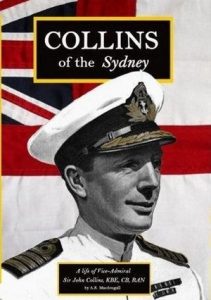- Author
- Book reviewer
- Subjects
- Biographies and personal histories, History - WW2, Book reviews, Influential People, Biographies
- Tags
-
- RAN Ships
- None noted.
- Publication
- December 2019 edition of the Naval Historical Review (all rights reserved)

By Tony Macdougall, published by Clarion Editions, 77 Lewis Street, Mudgee, NSW 2850. Tel: 02 6372 1387 or email: macdougallburns@bigpond.com.au. A quality paperback of 576 pages with many photographs and illustrations at $39.95 rrp.
In December 1912 John Collins was selected by the Australian Naval Board as one of 28 young gentlemen destined to be the first entrants to the new RAN College at Geelong in 1913. Writing later, Collins said: how fortunate he was that the Navy had been his selected life. He wrote ‘I never wanted anything else’.
Seventy-seven years later, on the death of Sir John Collins in 1989, the Chief of Navy, Vice Admiral Mike Hudson, in a letter to Lady Phyllis Collins, wrote of ‘…the Navy’s depth of appreciation and the honoured place Collins will have in the annals of the Senior Service. He was one of Australia’s greatest sailors and statesmen who gave much to the nation’. Rear Admiral Sir David Martin, Governor of New South Wales, described Sir John Collins, as a ‘…kind, understanding and imaginative man who made those around him feel special’.
Within those 77 years there were over 43 continuous years ashore and afloat with the RAN plus 6½ years of statesmanship as Australia’s High Commissioner to New Zealand. Unfortunately, in full consideration of his wife’s medical status, he declined an offer from the Prime Minister, Sir Robert Menzies, to become Governor General of the Commonwealth of Australia.
Sir John wrote a book covering some of the highlights of his career called As Luck Would Have It: The reminiscences of an Australian sailor. He dedicated the book simply ‘To my wife: who packed and followed’.
In Tony Macdougall’s comprehensive volume we read of Collins’ school days in East Melbourne, cadet midshipman at the college, midshipman at Scapa Flow at the same time as Prince Albert, later King George VI, and Lord Louis Mountbatten. He won the Egerton Memorial prize for topping the gunnery course at HMS Excellent, and put this knowledge into practice as gunnery officer and squadron gunnery officer.
He commanded the destroyer HMAS Anzac and then the cruiser HMAS Sydney. Precise and intriguing details are given of the Battle of Cape Spada in the Aegean Sea which occurred in July 1940 when Sydney sank the Italian cruiser Bartolomeo Colleoni and crippled another Italian cruiser Giovanni della Bande Nere. Admiral Cunningham, the Commander in Chief Mediterranean called Collins and Sydney ‘his stormy petrel’. Following this success, he was made a Companion of the Order of the Bath. He was the first captain of HMAS Shropshire when she was transferred to the RAN.
He became a Commodore commanding the British Far Eastern Squadron and was appointed to the America, British, Dutch, Australia (ABDA) command. Here, events leading to the evacuation of Singapore and Java are covered. He commanded the Australian squadron operating with the US 7th Fleet in the Pacific and flew his broad pennant in HMAS Australia during the crucial US landings in the Philippines. At this time Australia was heavily damaged by attacks from Japanese aircraft. Collins was badly wounded (some say he was only saved by his steel helmet) while his Flag Captain, Emile Dechainaux, and 30 others were killed. After convalescing and again in command of the Australian squadron he was present in USS Missouri for the signing of the Instrument of Surrender by the Japanese.
Collins was in Singapore, helping to plan its defences in late 1941 when HM Ships Prince of Wales and Repulse were sunk. He was made Commodore China Force of RN and RAN ships. Singapore was being surrounded and collapsing whilst Allied Forces were defeated in the Battle of the Java Sea. Collins was one of the last to escape from Singapore to Java.
In mid-1944, at the Prime Minister’s instance, Collins was appointed Commodore First Class in command of the Australian squadron. On 8 January 1947, one day after his 48th birthday, he was promoted Rear Admiral and in February 1948, aged 49, he became the first Australian trained officer to become Chief of Naval Staff, proving to be a very capable, effective and shrewd CNS. In May 1950 he was promoted Vice Admiral, becoming the first RAN College graduate to reach that rank. In the 1951 New Year Honours List VADM Collins was created Knight Commander in the Most Excellent Order of the British Empire, KBE – regarded by many as a token of Menzies’ high esteem.
He saw the introduction of the Fleet Air Arm into the RAN and had oversight of the RAN’s participation in the Korean War and the Malay Emergency. Closer ties were developed with the USN in what became known as the Radford-Collins Agreement. Throughout this he was still able to maintain a successful association with the RN.
Vice Admiral Sir John Collins retired from the RAN on 22 February 1955, aged 56. He then had a successful and much admired term of 6½years as Australian High Commissioner in New Zealand, terminating in September 1962. This was the end of half a century of continuous service to the Crown.
Tony Macdougall’s book, Collins of the Sydney, is a most engaging and exciting read. A treasure trove of valuable and carefully collated information on the first Australian Chief of Naval Staff and the importance of his guidance, mostly during and immediately after the Second World War. Its main theme is cleverly interwoven with local and international history of the times. A full list of references is provided. The author is to be commended on this comprehensive and important biography. For anyone with an interest in the history of the RAN this book is strongly recommended.
Reviewed by: Kevin Rickard




